Drafts by Alessandra Livraghi
Papers by Alessandra Livraghi
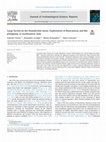
Journal of Archaeological Science: Reports, Jun 1, 2019
In northern Italy, Fumane Cave (Lessini Mountains-Verona), San Bernardino Cave, and De Nadale Cav... more In northern Italy, Fumane Cave (Lessini Mountains-Verona), San Bernardino Cave, and De Nadale Cave (Berici Hills-Vicenza) provide data to interpret the exploitation dynamics of the Pleistocene's large bovids Bos primigenius and Bison priscus between 70 and 42 ky BP. Through the taphonomic study of bone assemblages, we have attempted to reconstruct the strategies, methods, and butchery practices in the exploitation of these game animals adopted by different cultural groups of Middle Palaeolithic hunters. Therefore, Neanderthal hunting behaviour has been examined using different proxies such as the choice of anatomical parts, selective transport of elements, prey selection, and age estimation. Results suggest bovines were an important subsistence resource in some cases, even if they were not the most exploited taxa in others, indicating differences and similarities depending on the context across the Italian peninsula. These results highlight additional aspects of Neanderthal landscape use and hunting strategies.
Quaternary International, Jun 1, 2021
This is a PDF file of an article that has undergone enhancements after acceptance, such as the ad... more This is a PDF file of an article that has undergone enhancements after acceptance, such as the addition of a cover page and metadata, and formatting for readability, but it is not yet the definitive version of record. This version will undergo additional copyediting, typesetting and review before it is published in its final form, but we are providing this version to give early visibility of the article. Please note that, during the production process, errors may be discovered which could affect the content, and all legal disclaimers that apply to the journal pertain.
Palaeogeography, Palaeoclimatology, Palaeoecology, Oct 1, 2018
Marine Isotope Stage 4 (MIS 4; ca. 71-57 ka) is not well documented in European continental conte... more Marine Isotope Stage 4 (MIS 4; ca. 71-57 ka) is not well documented in European continental contexts and is characterized mainly by minimum summer insolation, producing a maximum extension of the polar ice caps during the Late Pleistocene together with a lowering of the sea level in the Northern Hemisphere. The De Nadale Cave site, located at an altitude of 130 m a.s.l. in the Berici Hills in northeastern Italy, contains a single archaeological layer (Unit 7) dated to MIS 4. In this paper, we present a palaeoenvironmental and palaeoclimatic reconstruction based on small-mammal (insectivore, bat and rodent) assemblages from this layer. Habitat Weighting and Bioclimatic Model methods were used in order to reconstruct the palaeoenvironmental and palaeoclimatic conditions. The results identify a cold climatic period with a

American Journal of Physical Anthropology, Oct 5, 2016
The aim of the study is the assessment of Nadale 1, a Neanderthal deciduous tooth recently discov... more The aim of the study is the assessment of Nadale 1, a Neanderthal deciduous tooth recently discovered in Northeastern Italy in the De Nadale cave (Middle Palaeolithic). Together with the clear archaeological context of the site, this study brings new insight on Neanderthal behavior and dental morphological variability. We used microCT data to provide a morphological description and morphometric analysis (diameter measurements and dental tissue volumes) of the Nadale 1 human tooth. Microwear analysis, taphonomical investigation and caries identification were performed using a stereomicroscope and Scanning Electron Microscope. In terms of morphology (i.e., incipient tuberculum molare, marked mesial marginal ridge and well-developed mid-trigonid crest connecting the protoconid and the metaconid, deep anterior fovea) and size, Nadale 1 presents features frequently observed in Neanderthal lower first deciduous molars. Microscope investigations reveal the presence of a small pit which could be correlated to an incipient caries. Nadale 1 expands the Italian Middle Palaeolithic fossil record and provides further information on Neanderthal dm1s in terms of dimensional and morphological variability. Furthermore, the presence of an incipient caries brings further data on Neanderthal diet.
Proceedings of the National Academy of Sciences of the United States of America, Nov 2, 2020
Journal of Archaeological Science: Reports, Apr 1, 2021
Abstract Bone retouchers are present in the human toolkit throughout the Lower and Middle Palaeol... more Abstract Bone retouchers are present in the human toolkit throughout the Lower and Middle Palaeolithic and appear in many contexts across Europe, sometimes in association with heavily retouched stone tools. Here we present the complete assemblage of bone retouchers recovered in the Mousterian Quina site of De Nadale Cave in the north of Italy dated to the onset of MIS 4. The results show that this assemblage is consistent – both in morphological and technological features - with bone retouchers recovered in the rest of Europe. The predominance of cervid and bovid limb bones is observed, and the study of the retouch-induced stigmata reveals intense modification of the lithic industry carried out on-site. This analysis contributes to our understanding of Neanderthal cultural and economic choices in the Quina complex in Europe.
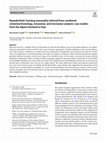
Archaeological and Anthropological Sciences, Feb 28, 2022
Herbivore teeth are a valuable source of information for inferring the hunting season of past hun... more Herbivore teeth are a valuable source of information for inferring the hunting season of past hunter-gatherers, the spatialtemporal organization of their activities, their socioeconomic organization, and their adaptation to the seasonal fluctuation of the resources. Numberless of studies have been conducted on Neanderthals across Eurasia, but only few of them rely on the application of cementochronology and tooth wear analyses combined to obtain information about the ungulate paleodiet, paleoenvironments, and the time range of the mortality events. In this study, we present the results achieved though the combination of these two high-resolution techniques applied to large and medium-sized herbivore teeth yielded by two Middle Paleolithic sites in the northeast of Italy. We combined the two methodologies with the aim to overcome any possible lack of information, due to the use of a single method. This study addressed to analyze the material coming from two caves in the Venetian region, De Nadale and San Bernardino, and to produce data supporting the interpretation of the origin of the two archaeofaunal assemblages as a result of seasonal hunting events that took place mainly in winter. In this specific geographic and environmental context, our data gain a better understanding of Neanderthal subsistence strategies and occupational patterns.
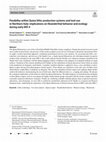
Archaeological and Anthropological Sciences, Nov 4, 2022
The Quina Mousterian is one of the well-defined Middle Paleolithic techno-complexes. Despite the ... more The Quina Mousterian is one of the well-defined Middle Paleolithic techno-complexes. Despite the pivotal research carried out in southwestern France, the presence of this techno-complex across the rest of Europe is still poorly documented. Here we apply a techno-functional approach, combining technological and use-wear analyses, for reconstructing lithic corereduction, tool-reduction, and tool use at De Nadale Cave, a single-layered Mousterian site with Quina features located in northern Italy and dated to the early MIS 4. Our results indicate that the flexible core reduction strategies identified at De Nadale show some similarities with the Quina knapping method, in addition to the adoption of centripetal methods on single surfaces. Variations of this scheme identified at De Nadale are the exploitation of lateral and narrow fronts which are aimed to the production of elongated, small blanks. A parallel, ramified reduction is applied to limace cores and Quina or demi-Quina scrapers having diversified purpose (mixed matrix). These blanks are exploited as tools and cores-on-flakes from which thinner, usable flakes or bladelets are detached. The use-wear identified on both scrapers and reaffutage flakes further confirm this behavior, demonstrating the use of both tools, albeit for different tasks (i.e., scraping and cutting). We discuss the ecological implications of this behavior within the Quina Mousterian. The high frequency of retouched tools and Quina or demi-Quina scrapers seems to accompany the highly mobile human groups associated with this techno complex and their seasonally organized subsistence strategies. Finally, by combining available multidisciplinary data on paleoenvironment, subsistence, and chronology, we were able to embed the neanderthal settlement of De Nadale in a regional and Western European frame, underlining the importance of the Quina Mousterian in Western Eurasia between MIS 4 and early MIS 3.
Alessia Nava, Federico Lugli, Matteo Romandini, Federica Badino, David Evans, Angela H. Helbling,... more Alessia Nava, Federico Lugli, Matteo Romandini, Federica Badino, David Evans, Angela H. Helbling, Gregorio Oxilia, Simona Arrighi, Eugenio Bortolini, Davide Delpiano, Rossella Duches, Carla Figus, Alessandra Livraghi, Giulia Marciani, Sara Silvestrini, Anna Cipriani, Tommaso Giovanardi, Roberta Pini, Claudio Tuniz, Federico Bernardini, Irene Dori, Alfredo Coppa, Emanuela Cristiani, Christopher Dean, Luca Bondioli, Marco Peresani, Wolfgang Müller, Stefano Benazzi
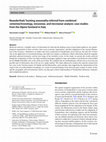
Archaeological and Anthropological Sciences, 2022
Herbivore teeth are a valuable source of information for inferring the hunting season of past hun... more Herbivore teeth are a valuable source of information for inferring the hunting season of past hunter-gatherers, the spatial–temporal organization of their activities, their socio-economic organization, and their adaptation to the seasonal fluctuation of the resources. Numberless of studies have been conducted on Neanderthals across Eurasia, but only few of them rely on the application of cementochronology and tooth wear analyses combined to obtain information about the ungulate paleodiet, paleoenvironments, and the time range of the mortality events. In this study, we present the results achieved though the combination of these two high-resolution techniques applied to large and medium-sized herbivore teeth yielded by two Middle Paleolithic sites in the north-east of Italy. We combined the two methodologies with the aim to overcome any possible lack of information, due to the use of a single method. This study addressed to analyze the material coming from two caves in the Venetian r...

Review of Palaeobotany and Palynology, 2021
Archaeological evidence of Middle Palaeolithic sites in Europe dating to MIS 4 remains very scarc... more Archaeological evidence of Middle Palaeolithic sites in Europe dating to MIS 4 remains very scarce compared to those belonging to previous (MIS 5) and later (MIS 3) periods. Of the few documented, a very low number have provided anthracological data reflecting the local landscape and fuel gathering strategies during MIS 4 Neanderthal occupations. This factor especially limits our knowledge of local landscape dynamics and the climatic conditions where these human occupations occurred. In this paper we contribute to this context through charcoal data from De Nadale cave, a single-layered Mousterian site located in northeastern Italy (Berici Hills area) and dated to 70.2 + 1/− 0.9 ka BP. Anthracological data suggests the preferential use of spruce / larch (Picea - Larix) as firewood together with cryophilous pines (Pinus tp. sylvestris) and birch (Betula sp.) indicating prevailing harsh climatic conditions. Additional analysis focused on taphonomic features affecting charcoal point out to advance decay evidence prior to charring caused by fungi and insects. Although further data is needed, our results provide complementary information agreeing with the faunal spectrum, the small mammals assemblage and the nearby terrestrial pollen sequences.
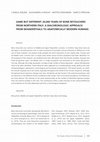
Bone retouchers are common in Middle and Upper Palaeolithic contexts. In northern Italy, these to... more Bone retouchers are common in Middle and Upper Palaeolithic contexts. In northern Italy, these tools are abundant in fi nal Mousterian sites. In order to pinpoint the possible cultural similarities or differences in the use of these artefacts, the present study analyses the bone retouchers of two nearby sites: Fumane and de Nadale caves. Fumane cave is a large cavity where various techno-complexes have been identifi ed. For the purposes of this research, we analysed more than 300 pieces from the Discoid, Levallois, Uluzzian and Proto-Aurignacian layers. De Nadale cave is a single occupation site attributed to the Quina Mousterian. This site, although still under excavation, includes a high number of bone retouchers – about 200 elements have so far been identifi ed. These elements were subjected to a multidisciplinary study, dealing with their archaeozoological, taphonomic, technological and functional characteristics. The faunal remains on which the retouch stigmata occur are simila...
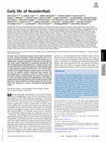
Proceedings of the National Academy of Sciences, 2020
The early onset of weaning in modern humans has been linked to the high nutritional demand of bra... more The early onset of weaning in modern humans has been linked to the high nutritional demand of brain development that is intimately connected with infant physiology and growth rate. In Neanderthals, ontogenetic patterns in early life are still debated, with some studies suggesting an accelerated development and others indicating only subtle differences vs. modern humans. Here we report the onset of weaning and rates of enamel growth using an unprecedented sample set of three late (∼70 to 50 ka) Neanderthals and one Upper Paleolithic modern human from northeastern Italy via spatially resolved chemical/isotopic analyses and histomorphometry of deciduous teeth. Our results reveal that the modern human nursing strategy, with onset of weaning at 5 to 6 mo, was present among these Neanderthals. This evidence, combined with dental development akin to modern humans, highlights their similar metabolic constraints during early life and excludes late weaning as a factor contributing to Neandert...

Journal of Archaeological Science: Reports, 2019
Abstract In northern Italy, Fumane Cave (Lessini Mountains -Verona), San Bernardino Cave, and De ... more Abstract In northern Italy, Fumane Cave (Lessini Mountains -Verona), San Bernardino Cave, and De Nadale Cave (Berici Hills - Vicenza) provide data to interpret the exploitation dynamics of the Pleistocene's large bovids Bos primigenius and Bison priscus between 70 and 42 ky BP. Through the taphonomic study of bone assemblages, we have attempted to reconstruct the strategies, methods, and butchery practices in the exploitation of these game animals adopted by different cultural groups of Middle Palaeolithic hunters. Therefore, Neanderthal hunting behaviour has been examined using different proxies such as the choice of anatomical parts, selective transport of elements, prey selection, and age estimation. Results suggest bovines were an important subsistence resource in some cases, even if they were not the most exploited taxa in others, indicating differences and similarities depending on the context across the Italian peninsula. These results highlight additional aspects of Neanderthal landscape use and hunting strategies.
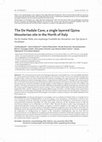
This article presents the results of archaeological exploration at De Nadale Cave, a new Late Mid... more This article presents the results of archaeological exploration at De Nadale Cave, a new Late Middle Palaeolithic site recently discovered in the Berici Hills, a karstic plateau in the north-east of Italy. A first survey and field campaigns have brought to light a small cavity almost totally filled with sediments embedding one single Mousterian layer sandwiched by sediments avoid of any relevant archaeological remains. A large herbivore tooth has been U-Th dated, with a minimum age of 70.2 +1/-0.9 ky BP. Several economic and cultural aspects make this site peculiar with respect to the others at the regional scale. The faunal remains record the abundance of large ungulates, mostly Megaloceros giganteus, but also Cervus elaphus and Bos/Bison. Their bone surfaces bear traces of human modification produced during skinning, dismembering, and fracturing of the carcasses and the long bone shafts for marrow recovery. There is a high number of bone retouchers in proportion to the fragmented ...

Review of Palaeobotany & Palynology, 2022
Archaeological evidence of Middle Palaeolithic sites in Europe dating to MIS 4 remains very scarc... more Archaeological evidence of Middle Palaeolithic sites in Europe dating to MIS 4 remains very scarce compared to those belonging to previous (MIS 5) and later (MIS 3) periods. Of the few documented, a very low number have provided anthracological data reflecting the local landscape and fuel gathering strategies during MIS 4 Neanderthal occupations. This factor especially limits our knowledge of local landscape dynamics and the climatic conditions where these human occupations occurred. In this paper we contribute to this context through charcoal data from De Nadale cave, a single-layered Mousterian site located in northeastern Italy (Berici Hills area) and dated to 70.2 + 1/− 0.9 ka BP. Anthracological data suggests the preferential use of spruce / larch (Picea - Larix) as firewood together with cryophilous pines (Pinus tp. sylvestris) and birch (Betula sp.) indicating prevailing harsh climatic conditions. Additional analysis focused on taphonomic features affecting charcoal point out to advance decay evidence prior to charring caused by fungi and insects. Although further data is needed, our results provide complementary information agreeing with the faunal spectrum, the small mammals assemblage and the nearby terrestrial pollen sequences.
Journal of Archaeological Science: Reports
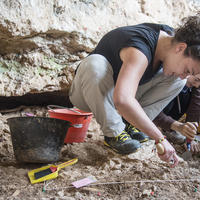
Uploads
Drafts by Alessandra Livraghi
Papers by Alessandra Livraghi